What analytical techniques are commonly used to detect and quantify Delta Octalactone in samples
2023-10-23
Detecting and quantifying Delta Octalactone in samples, whether in the fragrance or flavor industry or in scientific research, often requires specialized analytical techniques. These techniques are used to ensure accurate measurement and identification of the compound. Here are some commonly employed methods:
1. Gas Chromatography (GC): Gas chromatography is a widely used technique for the separation and quantification of volatile compounds, including Delta Octalactone. The compound is vaporized and then passed through a column where it separates from other compounds based on differences in volatility. It can be detected by a variety of detectors, such as flame ionization detectors (FID) or mass spectrometers (MS).
2. High-Performance Liquid Chromatography (HPLC): HPLC is used for non-volatile or less volatile compounds. It involves passing a liquid sample containing Delta Octalactone through a column under high pressure. The compound is separated and detected using UV, fluorescence, or other detectors.
3. Gas Chromatography-Mass Spectrometry (GC-MS): This powerful combination of gas chromatography and mass spectrometry is often used to identify and quantify Delta Octalactone. GC separates the compounds, and MS provides information about the compound's mass and chemical structure.
4. Liquid Chromatography-Mass Spectrometry (LC-MS): Similar to GC-MS, LC-MS combines liquid chromatography with mass spectrometry. It's suitable for less volatile compounds like Delta Octalactone.
5. Solid-Phase Microextraction (SPME): SPME is a sample preparation technique that involves the extraction of volatile and semi-volatile compounds from samples, which can then be analyzed by GC or GC-MS. It's particularly useful for headspace analysis.
6. Nuclear Magnetic Resonance (NMR) Spectroscopy: NMR spectroscopy can be used to identify and quantify compounds, including Delta Octalactone, based on their unique proton and carbon-13 spectra. It's particularly useful for determining the structure and purity of compounds.
7. Fourier Transform Infrared (FTIR) Spectroscopy: FTIR spectroscopy can be used to identify compounds based on their absorption of infrared radiation. While it may not be as commonly used for quantification, it can provide valuable information about the presence of Delta Octalactone in a sample.
8. Sensory Analysis: In the flavor and fragrance industry, sensory panels or trained individuals may be used to detect and evaluate the presence and intensity of Delta Octalactone in samples by relying on their olfactory senses.
The choice of analytical technique depends on the specific requirements of the analysis, the nature of the sample, and the sensitivity and selectivity needed to quantify Delta Octalactone accurately. These techniques, when used appropriately, help ensure the quality and consistency of products in various industries, particularly in flavor and fragrance formulations.



